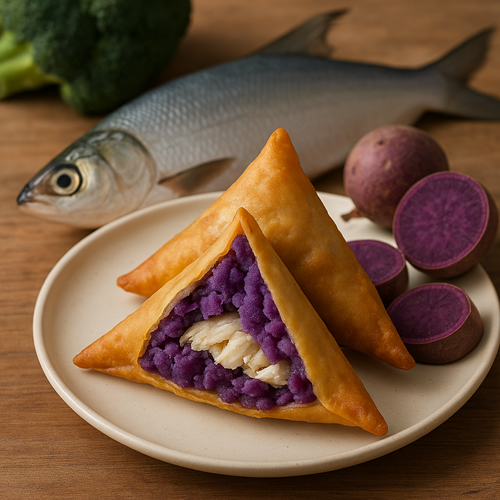Nutritional content and acceptability of milkfish and purple sweet potato sambusa in an effort to prevent stunting
Abstract
Background: Stunting remains a major public health issue caused by chronic malnutrition and recurrent infections. In South Sulawesi, Indonesia, the prevalence of stunting in 2024 was 23.3%. One contributing factor is chronic energy deficiency (CED) among pregnant women. The government promotes supplementary feeding (PMT) to address this. Sambusa made from milkfish (Chanos chanos) and purple sweet potato has potential as a local PMT due to its nutritional value and local availability.
Methods: This experimental study used a randomized design to analyze the sensory characteristics and nutritional content of Sambusa with milkfish and purple sweet potato substitution. The organoleptic test was conducted at the Organoleptic Laboratory of Poltekkes Kemenkes Makassar, and nutrient analysis (protein, omega-3, anthocyanin) at the Integrated Biotechnology Laboratory, Hasanuddin University, during May–June 2025.
Results: Sensory evaluation showed significant differences in color and texture (p<0.05) but not in aroma or taste (p>0.05). The protein content in the control (F0) and best formula (F3) was 13.88% and 13.72%, respectively. The proportion of omega-3 to total fatty acids increased from 0.74% (F0) to 0.78% (F3), and anthocyanin levels rose from 2.57 CyE/g (F0) to 7.85 CyE/g (F3).
Conclusion: Substitution with milkfish and purple sweet potato influenced the sensory and nutritional qualities of Sambusa. The modification enhanced omega-3 and anthocyanin content without significantly affecting protein levels. This product shows promise as a nutritious local supplementary food for pregnant women to help prevent stunting.
Downloads
References
Ashar, H. et al. (2025) ‘A qualitative study in Magelang Central Java Indonesia: Mothers’ knowledge, parenting styles and national priority programs managing of stunting in toddlers’, Social Sciences & Humanities Open, 12, p. 101874. doi: https://doi.org/10.1016/j.ssaho.2025.101874.
Astuti, S. J. W., Suindyah Dwiningwarni, S. and Atmojo, S. (2025) ‘Modeling environmental interactions and collaborative interventions for childhood stunting: A case from Indonesia’, Dialogues in Health, 6, p. 100206. doi: https://doi.org/10.1016/j.dialog.2025.100206.
Bhandari, D. et al. (2025) ‘Mapping multilevel adaptation response to protect maternal and child health from climate change impacts: a scoping review’, iScience, p. 111914. doi: https://doi.org/10.1016/j.isci.2025.111914.
Carlqvist, A. et al. (2025) ‘Comparative growth of children who are HIV-exposed and uninfected with those who are HIV-unexposed and uninfected at age 1 and 2 years in South Africa: a prospective cohort study’, eClinicalMedicine, 89, p. 103515. doi: https://doi.org/10.1016/j.eclinm.2025.103515.
Chowdhury, R. et al. (2025) ‘Impact of an Integrated Intervention Package During Preconception, Pregnancy, and Early Childhood on the Gut Microbiome at Six Months of Age: Findings from the Women and Infants Integrated Growth Study (WINGS) Randomized Controlled Trial’, The Journal of Nutrition, 155(7), pp. 2355–2366. doi: https://doi.org/10.1016/j.tjnut.2025.04.016.
Dominguez, G. B. et al. (2025) ‘Who protects the children and women of Sudan?’, The Lancet Child & Adolescent Health, 9(10), pp. 735–743. doi: https://doi.org/10.1016/S2352-4642(25)00237-8.
Eglovitch, M. et al. (2024) ‘Balanced Energy Protein Supplementation in Pregnancy: Adherence and Acceptability among Pregnant Women in Rural Ethiopia’, Current Developments in Nutrition, 8(7), p. 103796. doi: https://doi.org/10.1016/j.cdnut.2024.103796.
Gómez, L. et al. (2025) ‘Prenatal exposure to HIV pre-exposure prophylaxis and birth, growth, and social–emotional developmental outcomes throughout early childhood in Kenya: a prospective cohort study’, The Lancet Global Health, 13(3), pp. e467–e478. doi: https://doi.org/10.1016/S2214-109X(24)00471-6.
Gough, E. K. et al. (2024) ‘Bifidobacterium longum and microbiome maturation modify a nutrient intervention for stunting in Zimbabwean infants’, eBioMedicine, 108, p. 105362. doi: https://doi.org/10.1016/j.ebiom.2024.105362.
Haque, S. et al. (2024) ‘Drivers of child and women dietary diversity: Empirical evidence from a peri-urban area of Bangladesh’, Social Sciences & Humanities Open, 9, p. 100813. doi: https://doi.org/10.1016/j.ssaho.2024.100813.
Isdiany, N. et al. (2024) ‘Two Eggs A Day Can Increase Choline Intake and Size of Mid Upper Arm Circumference (MUAC) in Pregnant Women in Indonesia’, Current Nutrition & Food Science, 20(2), pp. 198–204. doi: https://doi.org/10.2174/1573401319666230418163039.
Jalloh, U. H. et al. (2025) ‘A mixed-methods study of the drivers of stunting reduction among children under-5 in Sierra Leone, 2005–2017’, The American Journal of Clinical Nutrition, 121, pp. S106–S112. doi: https://doi.org/10.1016/j.ajcnut.2025.02.015.
Kamruzzaman, M. et al. (2025) ‘Progress of healthier rice development in Bangladesh: A review’, Journal of Food Composition and Analysis, 139, p. 107082. doi: https://doi.org/10.1016/j.jfca.2024.107082.
Kamudoni, P. R. et al. (2024) ‘Context-Tailored Food-Based Nutrition Education and Counseling for Pregnant Women to Improve Birth Outcomes: A Cluster-Randomized Controlled Trial in Rural Malawi’, Current Developments in Nutrition, 8(12), p. 104506. doi: https://doi.org/10.1016/j.cdnut.2024.104506.
Kesehatan, B. kebijakan P. (2025) ‘SSGI 2024 Survei Status Gizi Indonesia Dalam Angka’, pp. 1–14. Available at: https://drive.google.com/file/d/1FmhMtFsElv0l95YNGqsoKy5xJh-m-glM/view.
Kinshella, M.-L. W., Moore, S. E. and Elango, R. (2025) ‘Current evidence around key underrepresented women’s health topics in pregnancy and postpartum nutrition: a narrative review’, Applied Physiology Nutrition and Metabolism, 50, pp. 1–16. doi: https://doi.org/10.1139/apnm-2024-0127.
Kumar, N. et al. (2024) ‘Women improving nutrition through self-help groups in India: Does nutrition information help?’, Food Policy, 128, p. 102716. doi: https://doi.org/10.1016/j.foodpol.2024.102716.
Landin Basterra, E. et al. (2025) ‘Impact of social protection on child malnutrition and mortality across 46 LMICs: a longitudinal study over two decades with insights from the COVID-19 pandemic’, eClinicalMedicine, 87, p. 103414. doi: https://doi.org/10.1016/j.eclinm.2025.103414.
Latif, S. A., Adam, A. and Kamaruddin, S. A. (2025) ‘Economic Income as a Cause of Stunting: an Analysis Based on the Perspective of Karl Marx: Literature Review’, Jurnal Ilmiah Kesehatan Sandi Husada, 14(1), pp. 1–7. doi: https://doi.org/10.35816/jiskh.v14i1.1231.
Liu, X. M. and Qiu, H. J. (2024) ‘The impact of international sanctions on food security and Sustainable Development Goal 2 (SDG-2)’, Public Health, 235, pp. 128–133. doi: https://doi.org/10.1016/j.puhe.2024.07.002.
Miller, F. et al. (2025) ‘Preconception malnutrition among women and girls in south Asia: prevalence, determinants, and association with pregnancy and birth outcomes’, The Lancet Regional Health - Southeast Asia, 36, p. 100573. doi: https://doi.org/10.1016/j.lansea.2025.100573.
Orimadegun, A. E. et al. (2025) ‘A mixed-methods study of the drivers of stunting reduction among children under five in Nigeria, 2008–2018’, The American Journal of Clinical Nutrition, 121, pp. S86–S94. doi: https://doi.org/10.1016/j.ajcnut.2025.02.022.
Putri, S. Z., Bachtiar, S. M. and Suprapto, S. (2025) ‘A Descriptive Case Series on Combined Education, Breast Care, and Oxytocin Massage for Lactation Support in Indonesia’, Journal of Public Health Sciences, 4(02), pp. 165–179. doi: https://doi.org/10.56741/IISTR.jphs.001030.
Sentika, R. et al. (2024) ‘Expert Consensus on Interprofessional Collaboration (IPC) Guidelines on Stunting Management in Indonesian Primary Healthcare (Puskesmas)’, The Open Public Health Journal, 17(1). doi: https://doi.org/10.2174/0118749445352608241119164446.
Sharma, D. et al. (2025) ‘Unveiling subgroup trends of stunting and wasting in Indian children: a serial cross-sectional analysis from National Family Health Surveys 3–5’, The American Journal of Clinical Nutrition, 121(5), pp. 1077–1089. doi: https://doi.org/10.1016/j.ajcnut.2025.01.027.
Southard, E. M. L. and Randell, H. (2024) ‘Food insecurity and women’s mental health in the Chitwan Valley of Nepal’, SSM - Mental Health, 6, p. 100337. doi: https://doi.org/10.1016/j.ssmmh.2024.100337.
Suprapto, S. et al. (2025) ‘OPTIMALCARE: Community-based homecare policy innovation in accelerating stunting reduction in Makassar City’, Abdimas Polsaka, 4(2), pp. 148–156. doi: https://dx.doi.org/10.35816/abdimaspolsaka.v4i2.107.
Tareke, A. A. et al. (2025) ‘Trends in overweight and obesity among reproductive-age women in sub-Saharan African countries from 1990 to 2030: Progress towards 2030 SDG nutrition targets’, Clinical Epidemiology and Global Health, 33, p. 102044. doi: https://doi.org/10.1016/j.cegh.2025.102044.
Udom, G. J. et al. (2025) ‘Heavy metal and metalloid pollution: A systematic review of health implications for pregnant women, children, and geriatrics in the East African region’, Environmental Advances, 19, p. 100620. doi: https://doi.org/10.1016/j.envadv.2025.100620.

Copyright (c) 2025 Lydia Fanny, Nur Armadiah, Rudy Hartono

This work is licensed under a Creative Commons Attribution 4.0 International License.




2.png)
1.png)
1.png)










